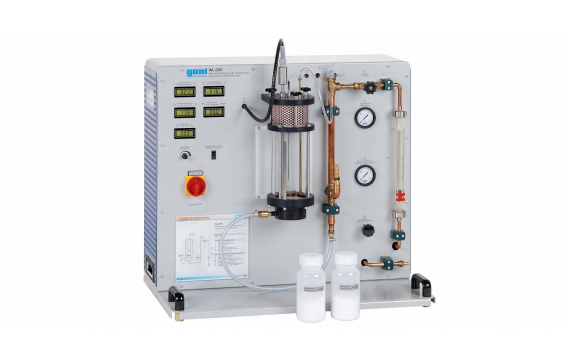WL 225 Heat transfer in the fluidised bed

Fluidised beds are used in a broad range of applications, e.g. for industrial drying, fluidised bed combustion or heat treatment of materials. Bulk solids are transformed from a fixed bed into a fluidised bed when fluids pass through them. In terms of fluid mechanical and thermodynamic properties, the fluidised bed behaves like an incompressible fluid.
The heat transfer between hot fluid and a fixed bed occurs mainly through heat conduction. Due to the movement of the particles, the fluid and the particles are very well mixed in the fluidised bed. This enables optimum heat transfer between fluid and particles and ensures an even temperature distribution in the reactor.
The core element in WL 225 is a backlit glass reactor which enables students to observe the fluidisation process. Compressed air flows upwards through a porous sintered-metal plate. On the sintered-metal plate is a fixed bed. If the velocity of the air is less than the so-called fluidisation velocity, the flow merely passes through the fixed bed. At higher velocities the bed is loosened to such an extent that individual solid particles are suspended by the fluid and form a fluidised bed. The air escapes through a filter at the top end of the glass reactor.
The air flow rate is set via a valve and measured with a flow meter. The pressure at the inlet into the reactor and in the fluidised bed is also measured.
A submersible heating element in the reactor enables examination of the heat transfer in the fluidised bed. Temperatures are measured by sensors at the air inlet of the reactor, on the surface of the heating element and in the fluidised bed and digitally displayed. The power output of the heating element is also digitally displayed. Aluminium oxide in various particle sizes is included in the scope of delivery as bulk solid.
- fluidised bed formation with air in a glass reactor
- illuminated glass reactor for optimal observation of the fluidisation process
Glass reactor
- capacity: 2150mL
- filling volume: approx. 1000mL
- operating pressure: 500mbar
Heating element
- power: 0…100W
Measuring ranges
- temperature: 1x 0…100°C, 2x 0…400°C
- flow rate: 0…6,5Nm3/h
- pressure: 1x 0…25mbar, 2x 0…1600mbar
- power: 0…200W
230V, 50Hz, 1 phase
230V, 60Hz, 1 phase; 120V, 60Hz, 1 phase
UL/CSA optional
- examination of the fluidised bed formation and the heat transfer in the fluidised bed
- fluidised bed of compressed air and aluminium oxide, particle sizes either 100µm or 250µm
- glass reactor, backlit
- glass reactor with sintered-metal plate at the inlet and air filter at the outlet
- heating element, submersible and with adjustable power output
- manual setting of the air flow rate via valve and flow meter
- instrumentation: temperature sensors at heater, air inlet, in fluidised bed, pressure measurement upstream of the reactor and in the reactor (manometer, pressure sensor), flow meter for measuring the air flow rate, power output of the heating element
- digital displays for temperatures, power output, pressure in the fluidised bed
- steel rulers for measuring the immersion depth of the heating element and the height of the fluidised bed
- safety valve, temperature switch at the heater, air filter at the outlet
- basic information on the fluidisation of fixed beds
- pressure curve within the bed
- pressure losses depending on
- flow velocity
- particle size of the bulk solid
- determination of the fluidisation velocity
- heat transfer in the fluidised bed
- influence of the air flow rate on the heat transfer
- influence of the heater position
- influence of the particle size
- determination of the heat transfer coefficient
